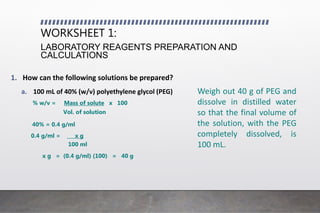
Laboratory reagent preparation and calc. worksheet
- 1. WORKSHEET 1: LABORATORY REAGENTS PREPARATION AND CALCULATIONS 1. How can the following solutions be prepared? a. 100 mL of 40% (w/v) polyethylene glycol (PEG) % w/v = Mass of solute x 100 Vol. of solution 40% = 0.4 g/ml 0.4 g/ml = x g 100 ml x g = (0.4 g/ml) (100) = 40 g Weigh out 40 g of PEG and dissolve in distilled water so that the final volume of the solution, with the PEG completely dissolved, is 100 mL.
- 2. WORKSHEET 1: LABORATORY REAGENTS PREPARATION AND CALCULATIONS b. 47 mL of 7% (w/v) solution of sodium chloride (NaCl) % w/v = Mass of solute x 100 Vol. of solution 7 % = 0.07 g/ml 0.07 g/ml = x g 47 ml x g = (0.07 g/ml) (47 ml) = 3.29 g Weigh out 3.29 g of NaCl and dissolve the crystals in some volume of distilled water less than 47 mL, a volume measured so that, when the 3.29 g of NaCl are added, it does not exceed 47 mL. When the NaCl is completely dissolved, dispense the solution into a 50 mL graduated cylinder and bring the final volume up to 47 mL with distilled water.
- 3. WORKSHEET 1: LABORATORY REAGENTS PREPARATION AND CALCULATIONS c. 200 mL of 95% (v/v) solution of ethanol % v/v = Vol. of solute x 100 Vol. of solution 95 % = 0.95 0.95 = x ml 200 ml x ml = (0.95) (200 ml) = 190 ml Measure 190 mL of 100% (200 proof) ethanol and add 10 mL of distilled water to bring the final volume to 200 mL. OR Ethanol : Dist. H2O 95 % 0.05 % 0.95 0.05 (0.95) (200 ml) (0.05) (200 ml) 190 ml 10 ml
- 4. 2. If 25g of NaCl is dissolved into a final volume of 500mL, what is the percent (w/v) concentration of NaCl in the solution? % w/v = Mass of solute x 100 Vol. of solution % w/v = 25 g NaCl x 100 500 ml % w/v = 5 % NaCl OR We can set up an equation of two ratios in which x represents the unknown number of grams. This relationship is read ‘x g is to 100 mL as 25 g is to 500 mL. x g = 25g 100 mL 500 mL Solving for x gives the following result: x g (25g)(100 mL) = 2500g = 5 g 500 mL 500 mL Therefore, there are 5 g of NaCl in 100 mL (5 g/100 mL), which is equivalent to a 5% solution.
- 5. 3. How will you prepare 200mL of 0.3M NaCl? OR Get first the wt. (g) of NaCl needed for 1 L of a 0.3 M solution. 58.45 g = x g 1 M 0.3 M g NaCl = 17.53 g Therefore, 17.53 g per Liter 17.53 g = x g 1000 mL 200 mL x g = 3.51 Using this formula, gs = MMs x M x V MMs of NaCl = 58.45 g/mol M = 0.3 M = 0.3 mol/L V = 200 mL = 0.2 L gNaCl = 58.45 g x 0.3 mol x 0.2 L mol L = 3.51 g Therefore, to prepare 200 mL of 0.3 M NaCl solution, 3.51 g of NaCl are dissolved in distilled water to a final volume of 200 mL.
- 6. 4. From a stock solution of 1M Tris solution, how will you prepare 400mL of 0.2M? Therefore, to 320 mL (400 mL - 80 mL = 320 mL) of distilled water, add 80 mL of 1 M Tris, pH 8.0, to bring the solution to 0.2 M and a final volume of 400 mL. Using this formula, M1V1 = M2V2 (1 M) (V1) = (0.2 M) (400 mL) V1 = (0.2 M) (400 mL) 1 M = 80 ml
- 7. 5. How is 4mL of 50mM NaCl solution prepared from a 2M NaCl stock? Therefore, to 3.9 mL of distilled water, add 0.1 mL of 2 M NaCl stock solution to produce 4 mL final volume of 50 mM NaCl. First, a conversion factor must be included in the equation so that molarity (M) can be converted to millimolarity (mM). 2 M x 1000 mM = 2000 mM 1 M Then, using this formula, M1V1 = M2V2 (2000 mM) (V1) = (50 mM) (4 mL) V1 = (50 mM) (4 mL) 2000 mM = 0.1 ml
- 8. 6. What is the molar concentration of a 10% NaCl solution? Therefore, a 10% NaCl solution is equivalent to 1.86 M NaCl. At 25⁰C, the density of 10% NaCl is 1.09 g/ml Mass of solution = vol x density = 1,000ml x 1.09 g/mL = 1,090 g Mass % = 10 % = 0.10 Molar mass of NaCl = 58.45 g To get molarity of 10% NaCl: (Mass of sol’n)(Mass%) = 1,090g x 0.10 = 1.86 moles MMNaCl 58.45g / mol 1 M = moles x 1.86 moles = 1.86 M Liter
- 9. OR We can use equations of ratios (if density value is not given.) Therefore, a 10% NaCl solution is equivalent to 1.71 M NaCl. Note: the value is close to the first computation First, 10 % NaCl contains 10 g of NaCl in 100 mL H2O. Determine the mass of NaCl in 1000 mL. 10 g = x 100mL 1000 mL x = 100 g ---> 1000 mL solution of 10% NaCl contains 100 g of NaCl. Then, using the gram molecular weight of NaCl (58.45), an equation of ratios can be written to determine molarity. In the following equation, we determine the molarity (M) equivalent to 100 g: x M = 1 M 100 g 58.45 g x = 1 M (100 g) 58.45 g = 1.71 M NaCl